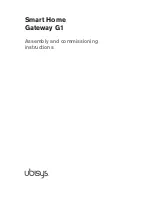
358
ifm
Device Manual SmartSPS AC14 with EtherNet/IP interface (AC1421, AC1422), Firmware 3.1.2
2015-11-30
Glossary of Terms
The software of redundant systems should
differ in the following aspects:
• specification (different teams),
• specification language,
• programming (different teams),
• programming language,
• compiler.
>
remanent
Remanent data is protected against data loss
in case of power failure.
The
→runtime system for example
automatically copies the remanent data to a
→flash memory as soon as the voltage supply
falls below a critical value. If the voltage supply
is available again, the runtime system loads
the remanent data back to the RAM memory.
The data in the RAM memory of a controller,
however, is volatile and normally lost in case of
power failure.
>
RPI
RPI =
R
equested
P
acket
I
ntervall
>
RTC
RTC =
R
eal
T
ime
C
lock
Provides (batter-backed) the current date and
time. Frequent use for the storage of error
message protocols.
>
RTS
RTS =
R
un
t
ime
S
ystem
Runtime systems are basic versions of
applications. These minimum versions are
supplied with certain products to meet the
prerequisites for the execution of the actual
product or to be able to look at or use results
generated by this product on other processors:
making available all routines required to
execute a program in a programming
language, e.g. interactions with the
→runtime
system, memory requirements, error routines,
inputs and outputs.
>
Runtime system
Basic program in the device, establishes the
connection between the hardware of the
device and the application program.
>
S
SD card
An SD memory card (short for
S
ecure
D
igital
Memory Card) is a digital storage medium that
operates to the principle of
→flash storage.
>
Self-test
Test program that actively tests components or
devices. The program is started by the user
and takes a certain time. The result is a test
protocol (log file) which shows what was tested
and if the result is positive or negative.
>
SELV
SELV =
S
afety
E
xtra
L
ow
V
oltage
Active parts of safety extra low voltage circuits
must neither be connected to ground nor to
protective wires of other circuits. They must be
safely separated from active parts with higher
voltage.
SELV circuit = secondary circuit (output
voltage) which is rated and protected so that
its voltages do not exceed a safe value in case
of correct operation (of the power supply) or in
case of a single
→fault (of the power supply).
SELV circuits are separated from the input
voltage (mains voltage) by double or enhanced
insulation. The voltage value must not exceed
60 V DC (or 42.4 V AC).
>
Single slave
→Slave whose address number may only
occur once on the
→master.
>
Slave
Passive participant on the bus, only replies on
request of the
→master. Slaves have a clearly
defined and unique
→address in the bus.
>
Slave configuration
The following terms need to be distinguished...
• AS-i projected configuration (→
PCD
(
• AS-i current configuration (→
CDI
(
• CTT projected configuration (→
PCCD
(
• CTT current configuration (→
CCDI
(
>








































